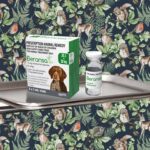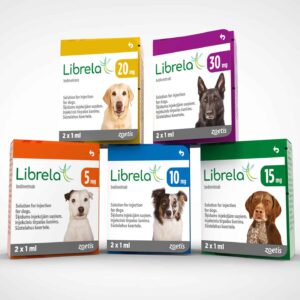Librela®, A New Approach To Arthritis Pain In Your Dog
Ron Hines DVM PhD
 Librela® Dog Owner Feedback Page
Librela® Dog Owner Feedback Page
 Dealing With Joint And Back Pain In Your Older Dog
Dealing With Joint And Back Pain In Your Older Dog


In a small USA trial, 47.4% of dog owners whose pets took Librela® (bedinvetmab) injections monthly for arthritis thought it might have been helpful to their pet in reducing its arthritis pain. But 36.6% of the dog owners whose dogs received placebo injections thought their dog improved too. (read here) So through 2023, I believe that Zoetis did not find the drug spectacular enough to be profitable in the United States (at least I couldn’t bring it up for purchase through my Zoetis account). Prior to marketing, companies like Zoetis usually make sure that their produce, in this case bedinvetmab, has a Wikipedia page. Through 3/13/23 there was none. To the best of my knowledge, in 2023 it was available in the UK and mainland Europe. I may be incorrect in some of my assumptions because I have no access to Zoetis’s internal decision making process.
This article about Librela repeats much of what you will find in another article of mine that concerns a very similar Zoetis anti-nerve growth factor (NGF) for arthritis pain management in arthritic cats, Solensia®. Solensia has been on the US market much longer. You can read some cat owner’s experience with that Solensia here. Because cats, are genetically, psycologically and metabolically quite different from dogs, you cannot assume that the benefits or hazards of the two drugs will be the same in both species. But both drugs are basically the same anti-nerve growth factor medication. It is just that the cat product, Solensia®, had to be bioengineered (“felinized”) to work in cats and Zoetis’ canine product, Librela®, has been bioengineered (“caninized”) to work in dogs. All MAB drugs like these are species-specific.
More About Librela
As I mentioned, Librela® is a new treatment option for your dog when it inevitably develops age-associated joint pain. Nothing lasts for ever and canine joints are no exception. With time, your dog’s cushoning and protective joint cartilage , composed of chondrocytes and the cartilage they produce stiffens in texture and loses its cushoning ability. The thickness and water content of the cartilage decrease and its joint lubricating ability decreases as well. Those changes eventually result in inflammation of the underlying bones that compose the joint. (read here) Bone erodes at pressure points, joints remodle in ways that encourage inflamation and pain. Dogs develop these problems at different ages and to different extents. An accident or repeated trauma to specific joints might make arthritic pain appear in those joints at a quite early age. Working dogs are apt to develop arthritis in the joints their work stresses the most. Breed conformation is very important as well. Dogs with body conformation quite different from primordial breeds may be cute to look at. But their breed cuteness comes at quite high a cost when it comes to health and longevity. Being larger-than-life for a breed is apt to bring blue ribbons and best of show. But that all comes with a price as well. (read here) Being overweight hastens the stress on a dog’s joints as well. Your dog will do most anything for you because it loves you. But please do not ask it to do physical things that will hasten arthritis pain.
No medication that is effective in lessening the pain of arthritis is free of potential side effects. The most common effective ones veterinarians dispensed to dogs are Rimadyl®, Previcox® and Galaprant®. Some vets dispense gabapentin (Neurontin®), a drug originally dispensed as a treatment for human epilepsy. Gabapentin’s effects on blocking arthritis pain in dogs are debatable.
However, in March of 2020, the FDA did agree to consider Pfizer’s request to conditionally approve tanezumab, the “humanized” form of the same anti-nerve-growth factor (NGF) that is in Librela® as a non-narcotic option for the treatment of knee and hip arthritis pain in people. However, in 2021 both the FDA and the EMA turned Pfizer down. The FDA vote was vote of 19 to 1 against approval – based on the findings that patients that took that drug needed knee or hip replacements sooner than patients that didn’t take it. It is not clear if their rapid joint deterioration was due to a decrease in pain that allowed them to use their joints too vigorously, or if the drug itself caused the problem in some other way.
The bar for new animal drug approvals is set lower than it is for drugs that are intended for use in people. Never publically expressed – but perhaps on the FDA’s mind is “let’s give the dog and cat versions a go first and see how that turns out”.
Do Veterinarians Need Better Chronic Pain Control Medications For My Dog Than They Have Now?
Yes, it would be wonderful if veterinarians and dog owners had more options for your dog. Things like therapeutic lazers have not been proven to be any more effective against arthritis pain than heating pads or hot water bottles. CBD/Hemp oils, peddled by various veterinary supply houses have no proven pain relieving properties in pets or people. (read here & here)
We veterinarians have the same tools today that your physician has to treat arthritic and other chronic pain should they occur:
We can give your dog NSAIDs like carprofen (Rimadyl®), firocoxib (Previcox®), grapiprant (Galliprant®) or meloxicam (Metacam®) to decrease your pet’s joint inflammation and pain. Most dogs handle those drugs reasonably well. But more frequently that we would wish for, side effects occur that include gastrointestinal irritation, vomiting, a drop in appetite and diarrhea. Physicians prescribe some of these same NSAID drugs to their patients. Never give one prescribed for a human family member or sold over-the-counter to a dog.
Veterinarians can give your dog corticosteroid injections or corticosteroid pills such as prednisone . They are all potent blockers of chronic joint inflammation and the pain that it produces. However, corticosteroids also have serious side effects when given frequently that include weight gain, fluid retention, excessive thirst and urination, panting, increased susceptibility to infections – even Addison’s disease upon withdrawal, etc. They are best reserved for diseases for which no other treatment options exist.
Some veterinarians dispense narcotics like tramadol for pain, or even fentanyl (Duragesic®) patches when nothing else is effective anymore. How effect tramadol might be in countering arthritis pain remains unknown. You would have to be the judge of that. Fentanyl is a powerful pain-relieving narcotic. Because of diversion fears, the DEA prefers that veterinarian’s confine its use to post-surgical pain or to a pet whose potential time on the earth is brief – such as terminal cancer patients.
There are veterinarians who suggest acupuncture, homeopathic remedies and “alternative medicine” for the control of pain in your dog. (read here) But there is no high quality scientific evidence that any of those things actually work – in pets or humans. (read here & here) Other vets, as I mentioned, suggest therapeutic laser therapy as an alternative to traditional physiotherapy. And still others suggest mood-altering drugs like amitriptyline or imipramine based on their use in treating human fibromyalgia. None of these are likely to do your dog any harm when given under veterinary supervision. But I personally have no faith in any of them. Giving your dog extra time, love and affection and altering its lifestyle to deal with its disabilities is likely to do it considerably more good than mood modifying drugs designed to treat depression.
How Does Librela® Fit Into My Dog’s Treatment Options?
The international Development Group’s 2023 international guidelines for the treatment of arthritis in dogs suggests Librela injections be given every 4 weeks. They mention that it hasn’t been on the market long enough yet to judge its long-term effects or drawbacks. They suggest ~2 months trial to judge its effectiveness in relieving arthritis pain and, if it is effective and side effects, if any, are minimal, the treatment can continue. Three of the 9 veterinarians specialists on the panel preferred relying on NSAID medication in mild to moderate arthritis pain situations (stage1). Six out of the 9 found it acceptable to use NSAID or another medications that had been studied longer or Librela® in stage 1 cases. (read here) Some of these specialists groups receive pharmaceutical company largesse in direct or roundabout ways. There is a link here and at the top of this webpage of dog owner’s actual experiences using Librela®.
What Is Nerve Growth Factor (NGF) And What Part Does It Play In My Dog’s Arthritis Pain?
Nerve growth factor is a small, protein-like molecule that individual nerve cells (neurons) rely on to communicate with each other. Among NGF’s many chores, it is esential for the development and later health of nerves that sense pain. During growth and development, NGF helps determine which neurons survive and prosper (read here) and has more recently been found to have a host of different functions within the mature body ranging from insulin secretion from the pancreas (read here) to allergic inflammation. (read here) Librela® was designed to cause your dog to have less NGF in its blood. That could mean less arthritis pain, but veterinarians know very little about what else might occur.
The nerve highway through which signals travel in you and your dog’s body is a two-way street. Some nerve signals travel from your dog’s brain to the far ends of its twig-like branches throughout it’s body to tell cells there what to do (motor neurons). Others travel in the opposite direction, from those fine end branches to its brain to communicate cold, warmth, taste, feel, smell, etc. Those are called sensory neurons. The finger-like ends of some sensory neurons appear to only sense pain. (read here) Drugs like Librela are all monoclonal antibodies (mAb’s) – protein “smart bombs” carrying “payload” antibodies that seek out and disable (in theory) only one compound within the body. Some are designed to destroy cancer cells, others, like Cytopoint®, to destroy compounds involved in your dog’s itching, others to fight asthma and a variety of other diseases in people. (read here)
What Do Studies Tell Us About The Effectiveness And Safety Profile Of Medications Similar To Librela®?
The basic science behind Librela® appears valid, and it would be wonderful if Librela® turns out to be an unqualified successes. But it is impossible to predict that based on the Zoetis-sponsored studies that have been released to the public so far. Lavish drug company publication-funding made it harder and harder for people like me to determine the true worth of medications and procedures across the entire spectrum of veterinary medicine. There is no doubt in my mind that purse string control influences study outcomes. (read here, here & here)
What About The Dog Owner Surveys That Where Conducted?
Purse string control often influences study outcomes. (read here, here & here) Pet Owner opinion has been found to be an unreliable way to measure a drug’s effectiveness. In one of Zoetis’ studies of Solensia®, the sister “felinized” equivalent of the “caninized” Librela®, 67% of cat owners whose cats received the placebo injection thought that their cat had improved after its injection too! That wasn’t much fewer than the number that thought their cat’s pain had lessened after the real injections. Activity monitors, like the one in this photo, are the only valid way to judge the effectiveness of any pain-control medication you give to your dog or your cat. (read here)
All older dogs will have mild to moderate evidence of joint wear and tear. We all do too. But just like in us, your dog can be reluctant to move and slow down for a plethora (a very large number) of reasons that do not have to do with its joints. Joint x-rays are also unreliable indicators of pain. Human studies have shown that only ~50% of people over the age of 65 that have x-ray evidence of arthritic knee joint changes experience any knee pain. And those that have joint pain do not necessarily have x-ray evidence of arthritis. As for hip pain, only 9.1 – 15.6% of people that experienced hip pain had any x-ray evidence of hip arthritis. And of those that did have evidence of hip arthritis, only 20% reported frequent hip pain. You yourself are the best judge as to whether Librela benefits you dog. If it does or if it doesn’t please let me know.




